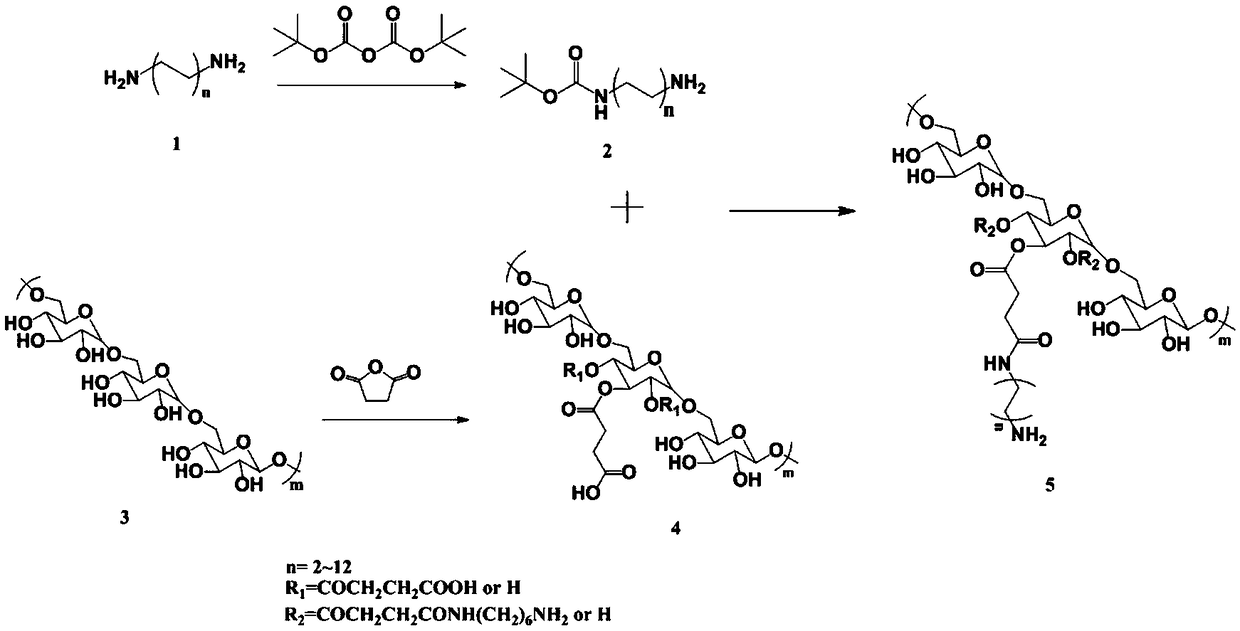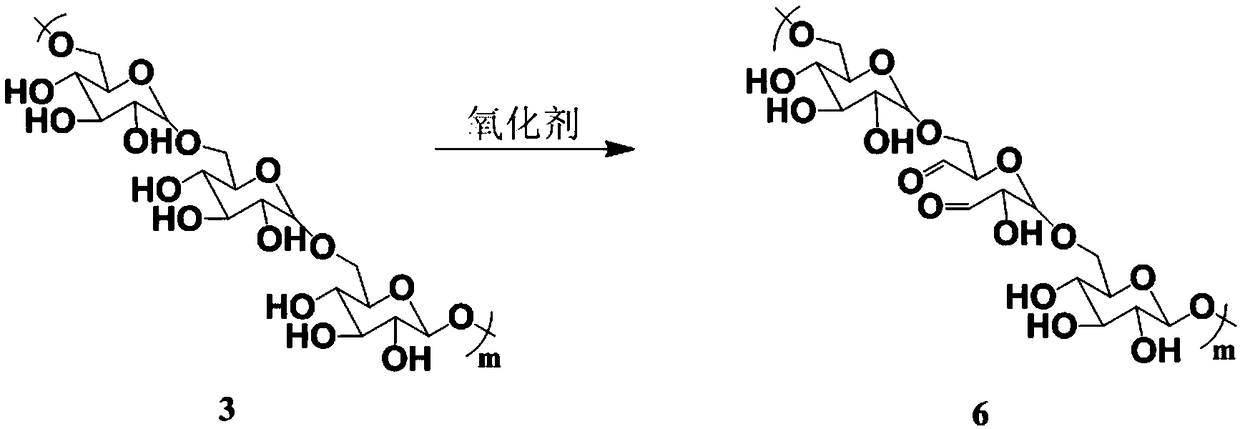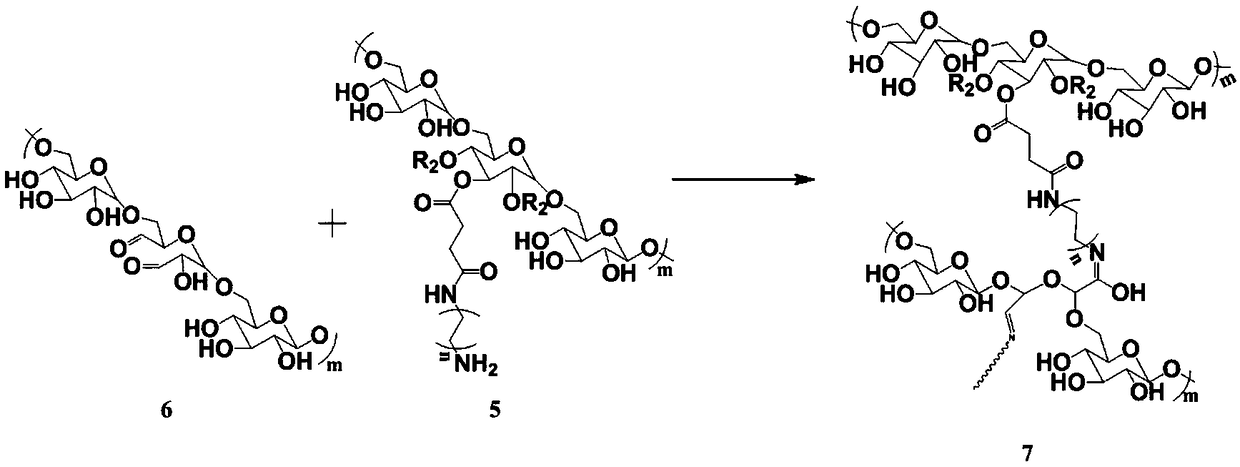Cellulose enhanced glucan-based injectable antibacterial hydrogel dressing and preparation method thereof
A technology of dextran and cellulose, which is applied in the field of cellulose-reinforced dextran-based injectable antibacterial hydrogel dressings and its preparation, can solve problems such as chronic wound healing obstacles, promote rapid healing, and remove free radicals , to avoid the effect of toxic side effects
- Summary
- Abstract
- Description
- Claims
- Application Information
AI Technical Summary
Problems solved by technology
Method used
Image
Examples
Embodiment 1
[0033] A preparation method of a cellulose-reinforced dextran-based injectable antibacterial hydrogel dressing is as follows:
[0034] a) Preparation of aminated dextran:
[0035] Di-tert-butyl dicarbonate (10 g, 0.0459 mol) was dissolved in dichloromethane (120 mL), and then ethylenediamine ( figure 1 Structural formula 1) (16.5g, 0.275mol), react at 0°C for 6-24 hours, remove dichloromethane with a rotary evaporator, then wash with 100mL saturated brine, then extract three times with 200mL ethyl acetate, and combine the organic layers , and dried overnight with anhydrous magnesium sulfate, filtered with suction, and removed ethyl acetate with a rotary evaporator to obtain the product ( figure 1 Structural formula 2).
[0036] At 90°C, the dextran ( figure 1 Structural formula 3) 2g is dissolved in the mixed solution of lithium chloride and N,N-dimethylformamide (the content of lithium chloride is 50%wt), after the dextran is completely dissolved, the solution is lowered t...
Embodiment 2
[0052] A preparation method of cellulose-enhanced dextran-based injectable antibacterial hydrogel dressing:
[0053] The difference between this embodiment and embodiment 1 is:
[0054] Step a) is:
[0055] Di-tert-butyl dicarbonate (10 g, 0.0459 mol) was dissolved in dichloromethane (120 mL), and then ethylenediamine ( figure 1 Structural formula 1) (16.5g, 0.275mol), react at 0°C for 6-24 hours, remove dichloromethane with a rotary evaporator, then wash with 100mL saturated brine, then extract three times with 200mL ethyl acetate, and combine the organic layers , and dried overnight with anhydrous magnesium sulfate, filtered with suction, and removed ethyl acetate with a rotary evaporator to obtain the product ( figure 1 Structural formula 2).
[0056] At 90°C, the dextran ( figure 1 Structural formula 3) 2g is dissolved in the mixed solution of lithium chloride and N,N-dimethylformamide (the content of lithium chloride is 50%wt), after the dextran is completely dissolve...
Embodiment 3
[0059] A preparation method of cellulose-enhanced dextran-based injectable antibacterial hydrogel dressing:
[0060] The difference between this embodiment and embodiment 1 is:
[0061] Step a) is:
[0062] Di-tert-butyl dicarbonate (10 g, 0.0459 mol) was dissolved in dichloromethane (120 mL), and then hexamethylenediamine dissolved in dichloromethane (120 mL) was added dropwise ( figure 1 Structural formula 1) (31.96g, 0.275mol), react at 0°C for 6-24 hours, remove dichloromethane with a rotary evaporator, then wash with 100mL saturated brine, then extract three times with 200mL ethyl acetate, and combine the organic layers , and dried overnight with anhydrous magnesium sulfate, filtered with suction, and removed ethyl acetate with a rotary evaporator to obtain the product ( figure 1 Structural formula 2).
[0063] At 90°C, the dextran ( figure 1 Structural formula 3) 2g is dissolved in the mixed solution of lithium chloride and N,N-dimethylformamide (the content of lithi...
PUM
 Login to View More
Login to View More Abstract
Description
Claims
Application Information
 Login to View More
Login to View More - R&D
- Intellectual Property
- Life Sciences
- Materials
- Tech Scout
- Unparalleled Data Quality
- Higher Quality Content
- 60% Fewer Hallucinations
Browse by: Latest US Patents, China's latest patents, Technical Efficacy Thesaurus, Application Domain, Technology Topic, Popular Technical Reports.
© 2025 PatSnap. All rights reserved.Legal|Privacy policy|Modern Slavery Act Transparency Statement|Sitemap|About US| Contact US: help@patsnap.com



